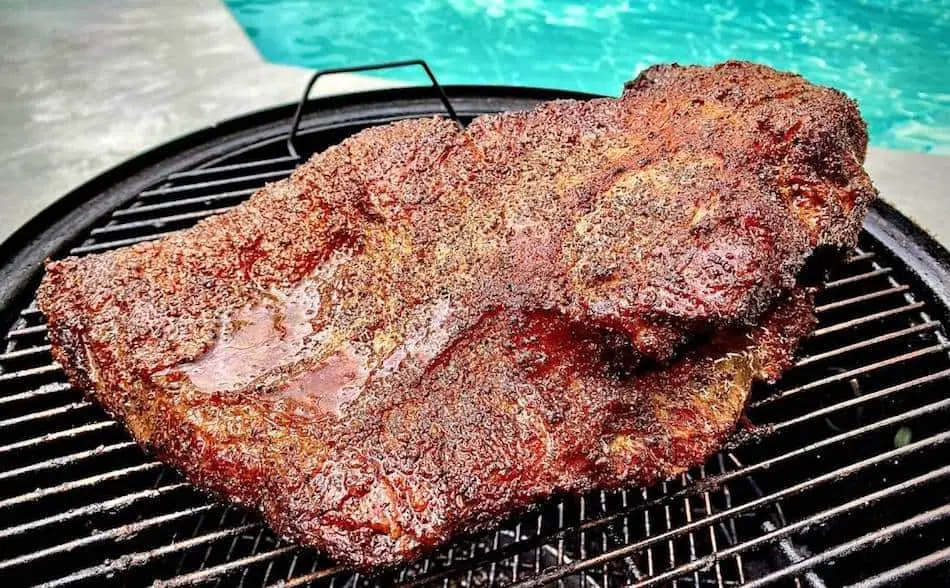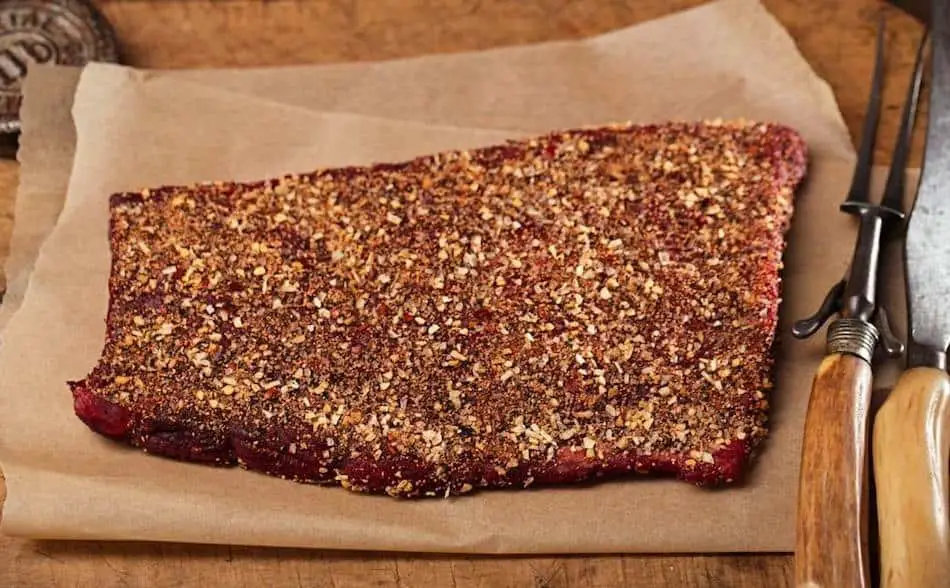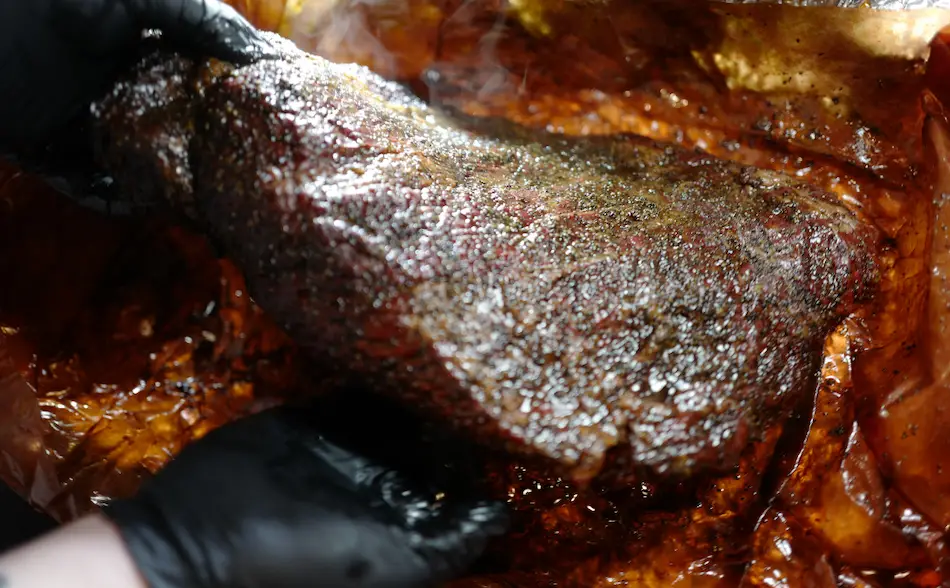
We all know the importance of wrapping brisket during the long smoking process. Wrapping stops the meat from drying out and speeds up the cooking when the temperature stalls. So when should wrap brisket? What is the ideal internal meat temperature? I did some research and found out what temperature competition pitmasters wrap their brisket.
So what temperature do we wrap brisket? We should wrap brisket when the internal temperature reaches 150°F (65.5°C). Brisket usually hits the stall around 150°F, and the internal temperature of the meat will increase minimally. Wrapping the brisket will speed up the cooking and push the brisket through the stall and move up towards 203° – 203°F.
| Action | Recommended Temperature | Result |
|---|---|---|
| Wrap brisket | 150°F (65.5°C) | Helps the meat continue cooking and reach an internal temperature of around 203°F, prevents the meat from drying out |
| Wrap brisket too early | Below 150°F (65.5°C) | Softens the bark, results in less smoke flavor |
| Wrap brisket too late | Above 150°F (65.5°C) | Causes the meat to take on too much smoke flavor, potentially tastes bitter |
Have you seen the most advanced thermometer on the market? FireBoard can be controlled via your phone, holds meat 6 probes, and records your cook data on a cloud.
What The Experts Say
There are different schools of thought on when to wrap a brisket being smoked in a smoker. Here are a few quotes from barbecue gurus, competition pitmasters, and experts on the subject:
“I wrap my briskets in foil when the meat hits around 165-170 degrees internal temp. I usually let the meat smoke for about 4-5 hours before wrapping. This allows for a good smoke ring to form.”
– Myron Mixon, champion pitmaster and author of “Smoke It Like a Pro”
“I wrap my briskets in foil when they hit the “stall” at 160-170 degrees. This is when the internal temp stops rising for a while. The foil helps to speed up the cook time and helps the meat to tenderize.”
– Tuffy Stone, champion pitmaster and owner of Q Barbecue restaurants
“I wrap my briskets at the point where the meat starts to become tender and the bark has set, usually around the 6-8 hour mark.”
– Aaron Franklin, owner of Franklin Barbecue and author of “Franklin Barbecue: A Meat-Smoking Manifesto”
As you can see, there is no one definitive answer to when the best time to wrap a brisket is. It can depend on the specific cut of meat, the desired level of smoke flavor, the desired tenderness, and the specific smoker being used. At the end of the day, the best way to determine when to wrap a brisket is to use a meat thermometer to monitor the internal temperature and make the decision based on the characteristics of the meat itself.
“Brisket Fat Side Up or Down? (We Settle The Debate)”
Wrapping Brisket at 150°F
The minimum internal temperature to wrap brisket is 150°F (65.5°C). Once the brisket hits 150°F, the temperature will stall as the meat ‘sweats’. When you wrap the brisket in foil or butcher paper, the brisket will power through the stall and the temperature will slowly rise towards 203°F. Make sure to double wrap the brisket in heavy duty foil so all the heat and steam are contained.
Wrapping Brisket at 170°F
You can wrap the brisket anywhere between 150°F and 170°F. Your brisket may not stall until it reaches a 170°F internal temperature. If the internal temperature keeps rising, smoke the brisket unwrapped until it stalls. This usually occurs at 150°F. The brisket should have taken on enough smoke at this stage and should be a reddish color.
Wrapping Brisket Too Early
You don’t want to wrap the brisket too early, otherwise it won’t take on enough smoke and you won’t get a decent bark. Depending on the size of the brisket, normally you would smoke the brisket for about 8-10 hours before wrapping. It will usually take this long to reach the 150°F – 170°F range. If you wrap the brisket too early, you won’t get that nice, crunchy bark. Wrapping will soften the bark, so one tip is to put the brisket back in the smoker unwrapped before slicing.
“Should I Wrap My Brisket In Paper or Foil? (Plus We Compare 11 Different Papers)”

Wrapping Brisket Too Late
There are pros and cons when it comes to wrapping brisket. If you wrap the brisket too late, then it’s going to take longer to cook and it may take on too much smoke. Wrapping will help the brisket push through the stall, therefore, take longer to reach the 203°F internal temperature. The meat will take on more smoke, can be good or bad depending on the type of smoke your smoker is producing. If it’s a nice clean smoke, then the extra smoke time will make your brisket taste smokier. However, if you expose the brisket to a dirty smoke for too long, then you brisket will taste bitter. One positive for delaying the wrapping is it will give your brisket more time to develop a bark. Once the foil or butcher paper goes on, the bark will soften.
Does Wrapping Brisket in Foil Cook it Faster?
Wrapping brisket is foil is a good way to accelerate the cooking because it will trap the moisture inside the parcel and create a steaming or braising effect. As the meat ‘sweats’, the moisture will cool the meat, causing the internal temperature to stall. Wrapping will hold all the heat inside the tight parcel and keep the temperature moving upwards. To ensure the meat has enough liquid, mop, baste or spritz the meat before you wrap it up.
Do You Wrap Brisket During the Stall?
It’s best to wrap a brisket just before it hits the stall, which is anywhere between 150°F and 170°F. You will notice the internal temperature will stop climbing and stagnate. Once the temperature has stalled, then wrap the brisket in foil or butcher paper. If you don’t, the meat will continue to cool as it sweats and will take forever to reach the 200°F range.
Does Wrapping Brisket Ruin Bark?
Unfortunately, wrapping the brisket will soften the bark because a lot of moisture gets trapped inside the parcel. Make sure you have developed a nice crust before wrapping and you can always put the meat back in the smoker or the oven to crisp up a little just before slicing. If you have created a good bark in the first stage of the cook, then it should survive the wrapping phase. After the brisket has rested, remove the foil and place it in the oven until the bark hardens. The other option is to put the brisket back in the smoker or lay it on the flames for a short while until you are satisfied with the bark formation.
Should Brisket Rest Covered or Uncovered?
You should always rest the brisket in its wrapping. The meat will continue to cook in the carryover time, so keeping it wrapped in this phase is important. The wrapping will also keep the juices contained, so you don’t lose your delicious sauce. The brisket will reabsorb much of its juices during the resting period. The best way to rest a brisket is to keep it in the foil, then wrap a towel around the parcel, then place it in a dry cooler. You should rest the meat for a couple of hours at least. It will still be hot even if it’s rested for 4 hours.

Foil vs Butcher Paper
Foil is the most common way of wrapping brisket, but the popularity of butcher paper has taken off in recent times thanks to brisket guru Aaron Franklin. Butcher paper is a specific kind of paper that works really well for brisket. What you choose to wrap your brisket is a personal preference, and the only way to know which you prefer is to experiment. You will notice the difference in the texture of the bark, but there is no right answer as to which is better. You can buy the butcher paper on Amazon by clicking here.
What Makes Brisket Dry? Here’s Five Reasons
- Wrapping brisket is one of the most important steps in the smoking process. Not only does wrapping help the brisket push through the stall and cook faster, it also helps the meat retain moisture.
- Temperature Control. Keeping the temperature of your smoker under control is one of the most important skills to master (if you are using a charcoal smoker). Brisket needs to be cooked low-and-slow over a long period, and if it isn’t, all the moisture will escape and your brisket will become dry.
- Resting. If you don’t allow your brisket to rest for at least 1-hour (longer is preferred), then your brisket will turn out dry. The resting time will allow the meat to reabsorb the juices as it continues to cook. You can rest a brisket for up to 4-hours. If you must slice the brisket after 1-hour, retain as much of the juice as possible and pour it over the brisket slices.
- Brining. Another way to ensure your brisket doesn’t dry out is to dry brine the meat the day before. This is a simple technique where all you need to do is rub salt over the brisket, wrap it in plastic and leave it in the fridge. The salt will penetrate the meat flesh, and during the cook, the salt will help the meat reabsorb moisture.
- Injecting. Injecting marinade, bone broth or other liquid into the brisket is another way of insuring that the brisket doesn’t dry out. If you don’t have a meat injector,they are inexpensive and simple to use. Check out the Beast Injector.
In Summary
- Wrapping brisket is recommended when the internal temperature reaches around 150°F (65.5°C)
- This is because the temperature tends to stall at this point and wrapping can help the meat continue cooking and reach an internal temperature of around 203°F
- Wrapping the brisket can also help to prevent it from drying out during the smoking process
- It is important not to wrap the brisket too early, as this can result in a softer bark and less smoke flavor
- On the other hand, wrapping the brisket too late can cause it to take on too much smoke flavor and potentially taste bitter
- When wrapping the brisket, it is important to use heavy duty foil or butcher paper to ensure that all of the heat and steam are contained

